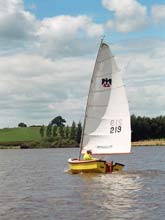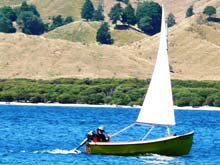When I started building my Welsford designed Truant daysailer in 2004, I gave serious thought as to what I could afford for the sail/mast ‘rig’. John Welsford recommends a ‘balanced lugsail’. However after getting a few quotes locally and from the USA, I found that was way over the limit I wished to spend at the time. I carefully budgeted the build, buying materials bit by bit, scavenging old fittings, using house paint for the hull, and using the cheapest and most basic tools to actually ‘do the job’. It all worked out – okay enough for starters anyway.
 |
The sail had patches, rust stains, and marks. But it worked! |
For the sail, I bought an entire 25 year old “phoenix” yacht, a 13’6” wooden ply sailboat complete with road trailer, then on-sold the hull only, keeping the rest. The sail was a standard Bermudan design, with forestay and side-stays. Its fully battened sail fitted onto the one piece, pre-curved, aluminium mast – over 20ft tall, and was hoisted up the channel via bolt-rope with a halyard. The boom was coated with old, peeling varnished, Oregon pine and the blocks and mainsheet were well past their effective use-by date. The sail had patches, rust stains, and marks. But it worked!
The problem was that since the rig was off a bigger hull than Truant. Designed for a 2 person sailing team to counter-balance, it had way too much power for this novice sailor. I capsized on the very first day and came very close quite a few more times over the remainder of that summers sailing. I became anxious over the power of the rig in fickle, blustery wind conditions. I had learnt a lot, and quickly, but the rig had to go.
| The problem was it had way too much power for this novice sailor. |
 |
Onto to Trade-Me (NZ equivalent of E-bay) I went, and found the mast and sail from a 13 ft ‘Seabird’ sailing dinghy – a fibreglass ‘clinker’ replica, hull design. It had a 2 piece mast, a bit under 6m (19ft), with a Bermudan, loose-footed, multi-coloured sail, a reasonable mainsheet and 2x good blocks attached. This was a more manageable arrangement. It sailed quite well and was much more predictable than the phoenix design, but I hated the 5 coloured sail.
In a flash of brilliance, I thought I could turn my hand to sail-making. I’d try to make a Gaff-rig out of it. Out came the shears and the domestic sewing machine. I lopped the top 4ft or so off the sail, following the diagonal stitching along the top of one panel. So far, so good. A new hem was sewn at the sails’ head and the search for a top yard, followed. An old sponge mop with a removable head was sacrificed to make this. It had metal jaws, which after garden hose was slid over them, fitted around the mast just perfectly. Brass eyelets were punched on the sail at 150mm intervals and the sail was lashed to the yard, with a halyard and pulley to provide up-haul.
 |
I found the mast and sail from a 13 ft ‘Seabird’ sailing dinghy, but I hated the 5 coloured sail. |
The two sections of the mast were trimmed by approx 3ft each (top and bottom so the joiner was not interrupted), making the mast the exact length for Johns’ lugsail design and a new pulley was riveted to the mast to pass the yard halyard through. A quick trail fit to establish the best fitting point for that halyard, to create the maximum yard height, and I was in business, so to speak. The sail still slid up a normal bolt-rope channel at the luff. On the first sail, it was immediately apparent this was a more fitting sail-plan for the hull. It was softer, better in gusty conditions, easier to handle in a strong blow and easy to de-rig and de-power when ‘landing’. The sail colours were still not fitting for a classical wooden boat design, though.
A drawback surfaced. Gaff rigs are notorious for poor windward performance. This was no exception – in fact was probably worse than most because of the lack of ‘fullness’ to the sail in its original form. I have tried tinkering with the yard angle and the foot in and outhauls, but it seems to have little (if any) difference to the overall performance of that sail.
| I have tried tinkering with the yard angle and the foot in and outhauls, but it seems to have little (if any) difference to the overall performance of that sail. |
 |
It still saw 2 summers of successful sailing, teaching me how to get the most out of it.
Last year (inspite of a suffering world economy) finances improved and I thought that if I didn’t do it then I never would, so I ordered the proper Balanced Lugsail from Chuck and Sandra at Duckworks. The arrival time was great. The sail was well made by sail-maker Bill (any pun intended? ‘duck’ Bill ?). John Welsfords’ rigging instructions, from the building plans, were easy to follow.
I scavenged some old(ish) fibreglass flag poles from display flags at work, and cut them to size for yard and boom. I’ll paint them brown (to give a wooden? look, later). They’re light and have what I think is about the correct amount of flex. The sail was lashed with a spiralling loop hitch to both – with adjusting knots for in-haul and out-haul. I was eager to give the newest (and final) rig a try, over our mid-summer Christmas break.
 |
Last year finances improved and I thought that if I didn’t do it then I never would, so I ordered the proper Balanced Lugsail. |
Verdict?
- At all points, it’s easy to sail – except within about 20 degrees to windward.
- Its ‘soft’ in changeable conditions, with just the right amount of twist at the top, to spill excess wind. Reaches are great.
- Downwind – it’s superb! Predictable, controllable and doesn’t lend itself to skittery gybes.
- Once tweaked, (I freely admit I haven’t got it quite right, yet) it’s easy to rig and de-rig.
- It’s not a racing sail, but shows quite spirited performance in winds over 10 knots.
- It ‘ghosts’ well in winds under 5 knots.
I chose the Egyptian cotton (cream colour) rather than white or tan, as I thought it may show less marks/stains.
| You’ll have more fun actually sailing your boat as the designer intended it to be. |
 |
Recommendation?
- Go with the sail pattern and size the designer has in mind – right from the start.
- Damn the cost! Buy the right thing – first time.
- Worry about paying for it later, you’ll find a way.
Although you will learn a lot and maybe have some fun changing sails and rigging, you’ll have more fun actually sailing your boat as the designer intended it to be.
Thanks to the Duckworks team for speedy delivery of the new sail. Love it!
Grahame Harris
|

